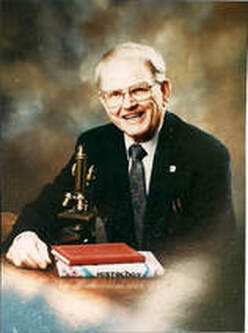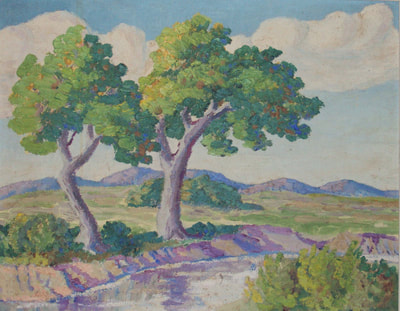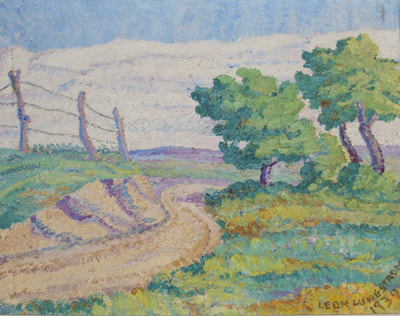"The Other Swedes"
~ Celebrating Them ~
~ The Smoky Valley Writers ~
~ Celebrating Them ~
~ The Smoky Valley Writers ~
Dr. Leon George Lungstrom
1915-2000
"Master Teacher" "Master Learner"
* * *
1915-2000
"Master Teacher" "Master Learner"
* * *
Were it not for the president and professors at Bethany College, Dr. Leon George Lungstrom most likely would have stayed on the family's humble farm located in the Kansas McPherson County New Gottland Township where he was born in 1915, to live and work there for the rest of his life.
Dr. Lungstrom retired at the end of the 1980-1981 school year, ending 30 years of association with the Bethany College faculty where he was a professor of biology. In his 397 page, 1990 book, "History of Natural Science and Mathematics at Bethany College, Lindsborg, Kansas," he referred to himself as a "workaholic." This may have been the reason for his wife, Linda Lungstrom, to sum up his life so simply and lovingly with this grave marker engraving:
Dr. Lungstrom retired at the end of the 1980-1981 school year, ending 30 years of association with the Bethany College faculty where he was a professor of biology. In his 397 page, 1990 book, "History of Natural Science and Mathematics at Bethany College, Lindsborg, Kansas," he referred to himself as a "workaholic." This may have been the reason for his wife, Linda Lungstrom, to sum up his life so simply and lovingly with this grave marker engraving:
"HUSBAND" "FATHER"
"MASTER LEARNER" "MASTER TEACHER"
-----------------------------------------------------------------------------------------------------------------------------
Bethany College Undergraduate
"MASTER LEARNER" "MASTER TEACHER"
-----------------------------------------------------------------------------------------------------------------------------
Bethany College Undergraduate
As a learner who needed more discipline in high school in Lindsborg, it looked at first that he might not make the grade to enter Bethany. From his book, on pages 234-235, he reveals that through the kindness of Dean Deere and President Ernst Pihlblad, they "gave him a chance" to attend Bethany as described below:
" . . . He was encouraged by his sister to try to enter college, but the finances necessary for this still seemed out of reach. One day in 1935 Professor Deere [who was also the College Dean] drove out to the Lungstrom farm to talk with Leon about attending Bethany. One problem existed -- his high school grades were not as good as they should have been and the president of the college, because of this, question whether they should give him financial assistance. Finally the president, Dr. Pihlblad, agreed with Professor Deere, 'At least let's give him a chance.'
"Leon Lungstrom began his studies at Bethany College in 1936 and was given the opportunity for N. Y. A. (National Youth Administration) student employment administered through the college. He immediately established a good academic record and maintained this record throughout his years. As a college student he worked summer months digging sewer ditches, running combines in harvest and doing construction work on the highway as well as other jobs to help pay for his college education. While an undergraduate student, he joined the Pi Sigma Chi fraternity and was initiated by two honorary fraternities, Lambda Sigma and Theta Chi Delta. He also became a member of the [Bethany] Linnean Society. During the senior year he was one of the students selected for Who's Who in American Colleges and Universities."
" . . . He was encouraged by his sister to try to enter college, but the finances necessary for this still seemed out of reach. One day in 1935 Professor Deere [who was also the College Dean] drove out to the Lungstrom farm to talk with Leon about attending Bethany. One problem existed -- his high school grades were not as good as they should have been and the president of the college, because of this, question whether they should give him financial assistance. Finally the president, Dr. Pihlblad, agreed with Professor Deere, 'At least let's give him a chance.'
"Leon Lungstrom began his studies at Bethany College in 1936 and was given the opportunity for N. Y. A. (National Youth Administration) student employment administered through the college. He immediately established a good academic record and maintained this record throughout his years. As a college student he worked summer months digging sewer ditches, running combines in harvest and doing construction work on the highway as well as other jobs to help pay for his college education. While an undergraduate student, he joined the Pi Sigma Chi fraternity and was initiated by two honorary fraternities, Lambda Sigma and Theta Chi Delta. He also became a member of the [Bethany] Linnean Society. During the senior year he was one of the students selected for Who's Who in American Colleges and Universities."
* * *
His Smoky Valley Art
as a student of
Professor Artist Birger Sandzén
who financially made a way for
Leon to attend an out-of-state group painting class.
His Smoky Valley Art
as a student of
Professor Artist Birger Sandzén
who financially made a way for
Leon to attend an out-of-state group painting class.
On page 236, second paragraph, of his book, Dr. Lungstrom writes:
". . . At one time while a student of professor Sandzén in a painting class, Lungstrom did not have the necessary funds to participate with the class in an out-of-state class tour. Upon learning about this difficulty, the professor gave Lungstrom money for the trip. One wonders how often this grand old gentleman helped students in need . . ."
". . . At one time while a student of professor Sandzén in a painting class, Lungstrom did not have the necessary funds to participate with the class in an out-of-state class tour. Upon learning about this difficulty, the professor gave Lungstrom money for the trip. One wonders how often this grand old gentleman helped students in need . . ."
--------------------------------------------------------
> Highlighting Dr. Lungstrom's Professional Life <
Covering his careers as an Entomologist and a Biology Professor
---------------------------------------------------------
Bethany College Graduate
1936-1940
Received the Bachelor of Science Degree, majoring in Biology and minoring in Chemistry
U. S. Army
1942-1946
Served in the Army specializing as a Fitzsimons Army Medical Corp instructor, Aurora, Colorado.
- In Atlanta, Georgia, studied the mosquito problems for the Malaria Control in War Areas program.
- In Kansas, presented reports on the mosquito problem for the State Board of Health.
- For the U. S. Public Health Service Center for Disease Control (C.D.C),
he was a medical entomologist researcher.
Entomologist, US Public Health Service, with U.S. Army, 1945
Entomologist, US Public Health Service, Kansas City, Kansas and Missouri, 1949-52
The Post Graduate Degrees and Studies
1946, Kansas State University Master of Science Degree in Zoology and Parasitology
1950, Kansas State University Ph.D. in Medical Entomology
1959 to 1960, California's Stanford University, eleven-months
1962, Arizona State University, studying desert biology
1965, Oklahoma University studying radioisotopes and reactor technology
1970, New Orleans, Tulane University's School of Tropical Medicine and Parasitology
NOTE
The first 3 universities studies were acquired through the National Science Foundation Grants. Due to his Arizona studies, he was able to develop two new laboratory procedures for the Physiology Laboratory at Bethany College.
The Honors and Listings
1979, Recipient of the Mildred Riddle McKeon Distinguished Professorship in Science
Listed in the Who's Who of American Men of Science
1979, listed in the North American Entomologists and Acrologists
published by the Entomological Book Society of America.
Published Contributor
April 1951, large contributor of mosquito data to the
Mosquito Records from the Missouri River Basin States,
Midwestern Communicable Disease Center, Kansas City.
[This was by the Survey Section Office of the U.S.P.H.S. [The Commissioned Corps of the U.S. Public Health Service]
Published three articles on mosquito research.
Bethany College Career
1946-1947
Biology Instructor
1952-1981
Biology Professor
Milfred Riddle McKeown distinguished professor in science., Bethany College, 1979
1981-2000
Professor Emeritus
//
THE TEACHER THAT HE WAS WHILE AT BETHANY
The Courses He Taught
General Biology, General Zoology, Invertebrate Zoology, Bacteriology, Parasitology, Entomology, Immunology, Human Physiology and Anatomy, Cell Biology, Comparative Anatomy, Embryology, Histology, Geology, Taxidermy.
During Interterm at times, it was courses in: Collecting Aquatic Invertebrate and helping to teach (noncredit) Conversational Swedish.
Science Achievements
He furthered the goals of Dr. Deere who built the foundation of a growing Science Department.
Bethany College Natural History Museum Assistant to Curator Dr. Emil O. Deere
Was the leading taxidermist
As a student and as a professor he mounted about 200 animals*
He gathered a collection of over 600 mounted animals for the Museum.
He was the acting curator for the Bethany College Museum move due curator Dr. Deere's death in 1966.
He played a major role in moving the Museum Natural History and Swedish Pioneer History Collections to the McPherson County Old Mill Museum
The Societies He Joined
Society of American Bacteriologist, the Association of Economic Etymologists, the American Association of Parasitologists, Gamma Sigma Delta, the American Association for the Advancement of Science and the Kansas Entomological Society.
The Travels He Took
1952, summer, three (3) summer months in Europe, including Sweden
visiting art galleries and museums
1954, summer, touring Alaska on a freighter by way of the inland passage
Publications
Kansas Academy of Science on the Bethany College Swedish scientists:
Dr. Udden, Dr. Welin and Dr. Deere.
Go HERE
Bethany College Museum Collections Representative
at the
McPherson County Old Mill Museum
c1966-1988
//
> Highlighting Dr. Lungstrom's Professional Life <
Covering his careers as an Entomologist and a Biology Professor
---------------------------------------------------------
Bethany College Graduate
1936-1940
Received the Bachelor of Science Degree, majoring in Biology and minoring in Chemistry
U. S. Army
1942-1946
Served in the Army specializing as a Fitzsimons Army Medical Corp instructor, Aurora, Colorado.
- In Atlanta, Georgia, studied the mosquito problems for the Malaria Control in War Areas program.
- In Kansas, presented reports on the mosquito problem for the State Board of Health.
- For the U. S. Public Health Service Center for Disease Control (C.D.C),
he was a medical entomologist researcher.
Entomologist, US Public Health Service, with U.S. Army, 1945
Entomologist, US Public Health Service, Kansas City, Kansas and Missouri, 1949-52
The Post Graduate Degrees and Studies
1946, Kansas State University Master of Science Degree in Zoology and Parasitology
1950, Kansas State University Ph.D. in Medical Entomology
1959 to 1960, California's Stanford University, eleven-months
1962, Arizona State University, studying desert biology
1965, Oklahoma University studying radioisotopes and reactor technology
1970, New Orleans, Tulane University's School of Tropical Medicine and Parasitology
NOTE
The first 3 universities studies were acquired through the National Science Foundation Grants. Due to his Arizona studies, he was able to develop two new laboratory procedures for the Physiology Laboratory at Bethany College.
The Honors and Listings
1979, Recipient of the Mildred Riddle McKeon Distinguished Professorship in Science
Listed in the Who's Who of American Men of Science
1979, listed in the North American Entomologists and Acrologists
published by the Entomological Book Society of America.
Published Contributor
April 1951, large contributor of mosquito data to the
Mosquito Records from the Missouri River Basin States,
Midwestern Communicable Disease Center, Kansas City.
[This was by the Survey Section Office of the U.S.P.H.S. [The Commissioned Corps of the U.S. Public Health Service]
Published three articles on mosquito research.
Bethany College Career
1946-1947
Biology Instructor
1952-1981
Biology Professor
Milfred Riddle McKeown distinguished professor in science., Bethany College, 1979
1981-2000
Professor Emeritus
//
THE TEACHER THAT HE WAS WHILE AT BETHANY
The Courses He Taught
General Biology, General Zoology, Invertebrate Zoology, Bacteriology, Parasitology, Entomology, Immunology, Human Physiology and Anatomy, Cell Biology, Comparative Anatomy, Embryology, Histology, Geology, Taxidermy.
During Interterm at times, it was courses in: Collecting Aquatic Invertebrate and helping to teach (noncredit) Conversational Swedish.
Science Achievements
He furthered the goals of Dr. Deere who built the foundation of a growing Science Department.
Bethany College Natural History Museum Assistant to Curator Dr. Emil O. Deere
Was the leading taxidermist
As a student and as a professor he mounted about 200 animals*
He gathered a collection of over 600 mounted animals for the Museum.
He was the acting curator for the Bethany College Museum move due curator Dr. Deere's death in 1966.
He played a major role in moving the Museum Natural History and Swedish Pioneer History Collections to the McPherson County Old Mill Museum
The Societies He Joined
Society of American Bacteriologist, the Association of Economic Etymologists, the American Association of Parasitologists, Gamma Sigma Delta, the American Association for the Advancement of Science and the Kansas Entomological Society.
The Travels He Took
1952, summer, three (3) summer months in Europe, including Sweden
visiting art galleries and museums
1954, summer, touring Alaska on a freighter by way of the inland passage
Publications
Kansas Academy of Science on the Bethany College Swedish scientists:
Dr. Udden, Dr. Welin and Dr. Deere.
Go HERE
Bethany College Museum Collections Representative
at the
McPherson County Old Mill Museum
c1966-1988
//
With Retirement
1981-2000
Granted
Emeritus Professor of Biology status and Emeritus Membership in the Kansas Academy of Science (KAS)
American Mosquito Control Association, and Sigma Chi Research Society memberships
Taught and Translated the Swedish Language
McPherson County Old Mill Museum Volunteer Work
Continued the work on the moved Bethany College Natural History Museum collections there as a College representative into the late 1980s
(This was ongoing work from the time of his role in moving the college collections to this museum in 1966.)
Was a McPherson County Old Mill Museum Co-Director from 1980-1984
with
Emeritus Professor Christian Swenson and Lindsborg resident Howard Patrick
//
1981-2000
Granted
Emeritus Professor of Biology status and Emeritus Membership in the Kansas Academy of Science (KAS)
American Mosquito Control Association, and Sigma Chi Research Society memberships
Taught and Translated the Swedish Language
McPherson County Old Mill Museum Volunteer Work
Continued the work on the moved Bethany College Natural History Museum collections there as a College representative into the late 1980s
(This was ongoing work from the time of his role in moving the college collections to this museum in 1966.)
Was a McPherson County Old Mill Museum Co-Director from 1980-1984
with
Emeritus Professor Christian Swenson and Lindsborg resident Howard Patrick
//
The Bethany College Natural History Museum Dr. Leon Lungstrom Collection
of the
McPherson County Old Mill Museum
1998
He mounted 200 and collected 600 of which half were donated from Kansas State University.
of the
McPherson County Old Mill Museum
1998
He mounted 200 and collected 600 of which half were donated from Kansas State University.
Authored
1990 "History of Natural Science and Mathematics at Bethany College, Lindsborg, Kansas"
Go HERE to Dr. Leon George Lungstrom ~ His Värmland Swedish ancestry and tough years on the McPherson County family farm.
* * *
"Let Us Celebrate Them"
* * *
Swedes: TheWayTheyWere
~ restoring lost local histories ~
reconnecting past to present
* * *
All color photography throughout Swedes: The Way They Were is by Fran Cochran unless otherwise indicated.
Copyright © since October 8, 2015 to Current Year
as indicated on main menu sections of
www.swedesthewaytheywere.org. All rights reserved.
"Let Us Celebrate Them"
* * *
Swedes: TheWayTheyWere
~ restoring lost local histories ~
reconnecting past to present
* * *
All color photography throughout Swedes: The Way They Were is by Fran Cochran unless otherwise indicated.
Copyright © since October 8, 2015 to Current Year
as indicated on main menu sections of
www.swedesthewaytheywere.org. All rights reserved.




